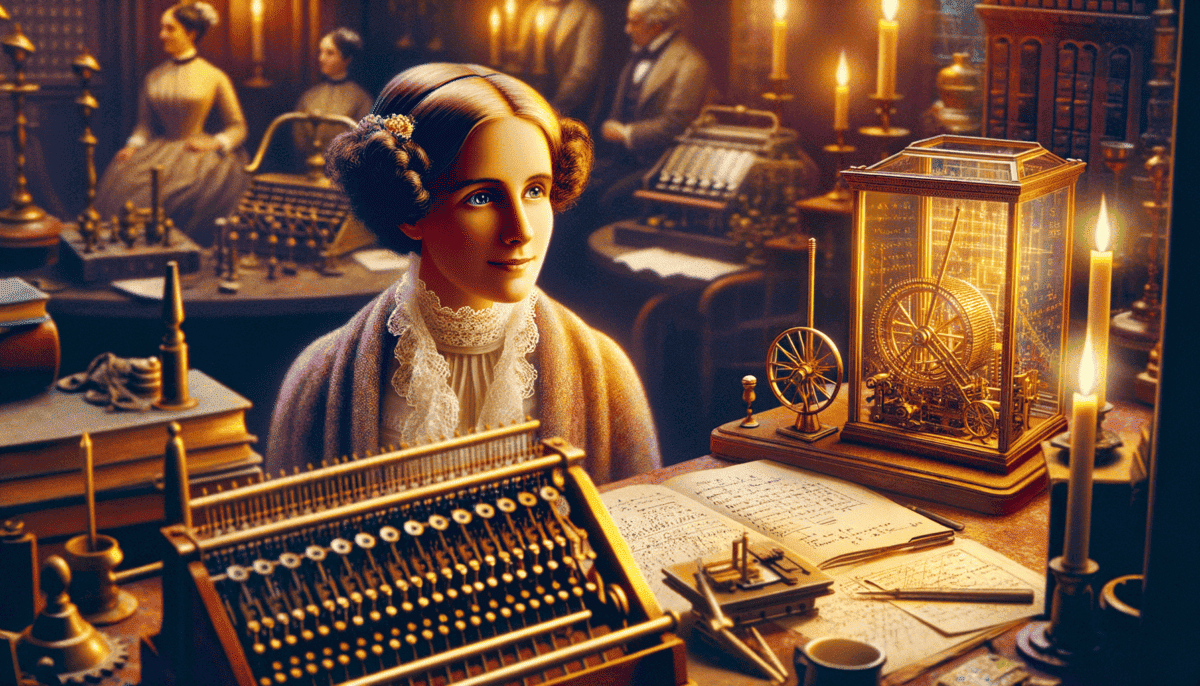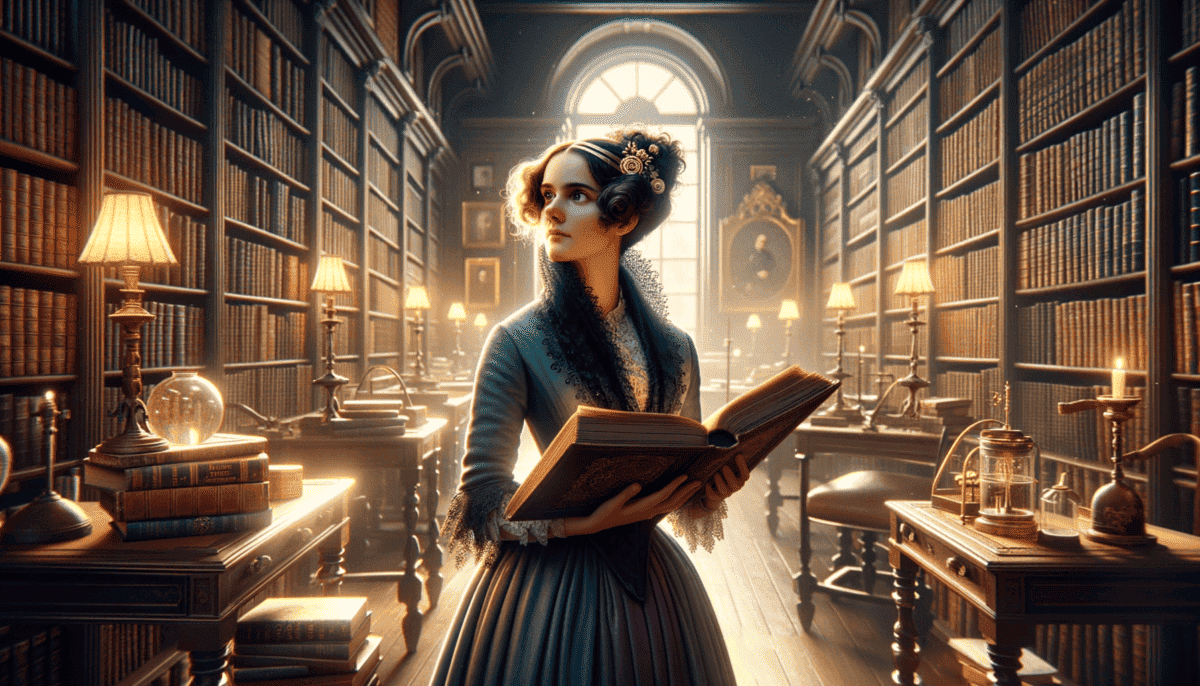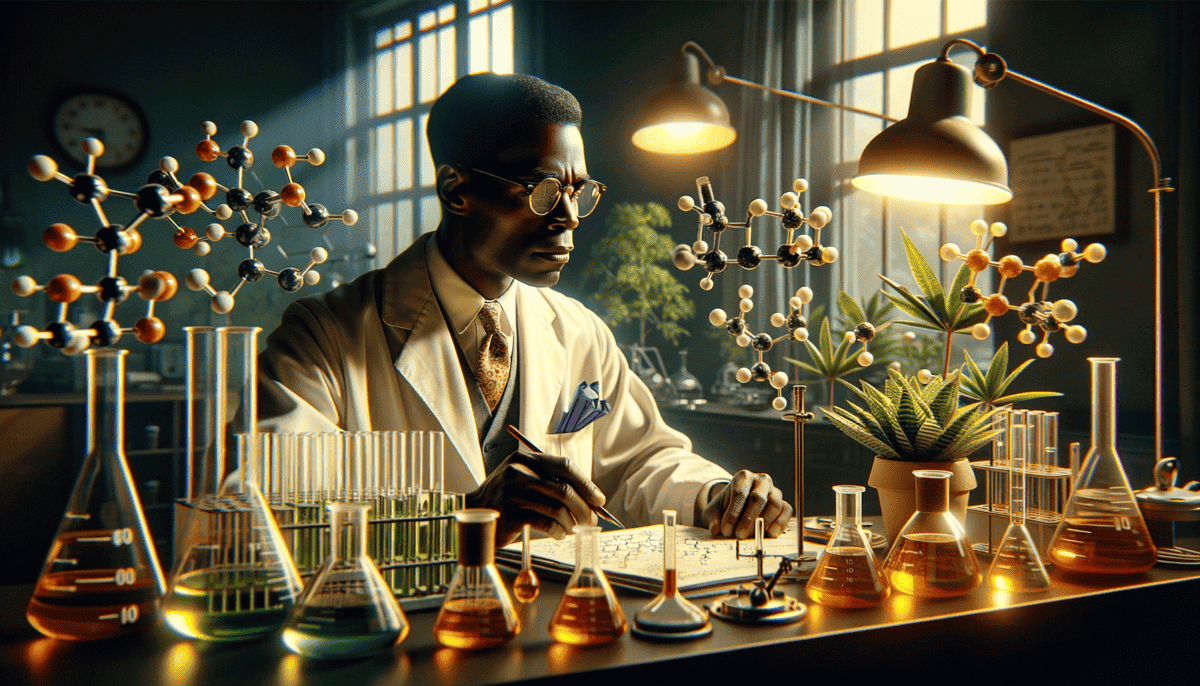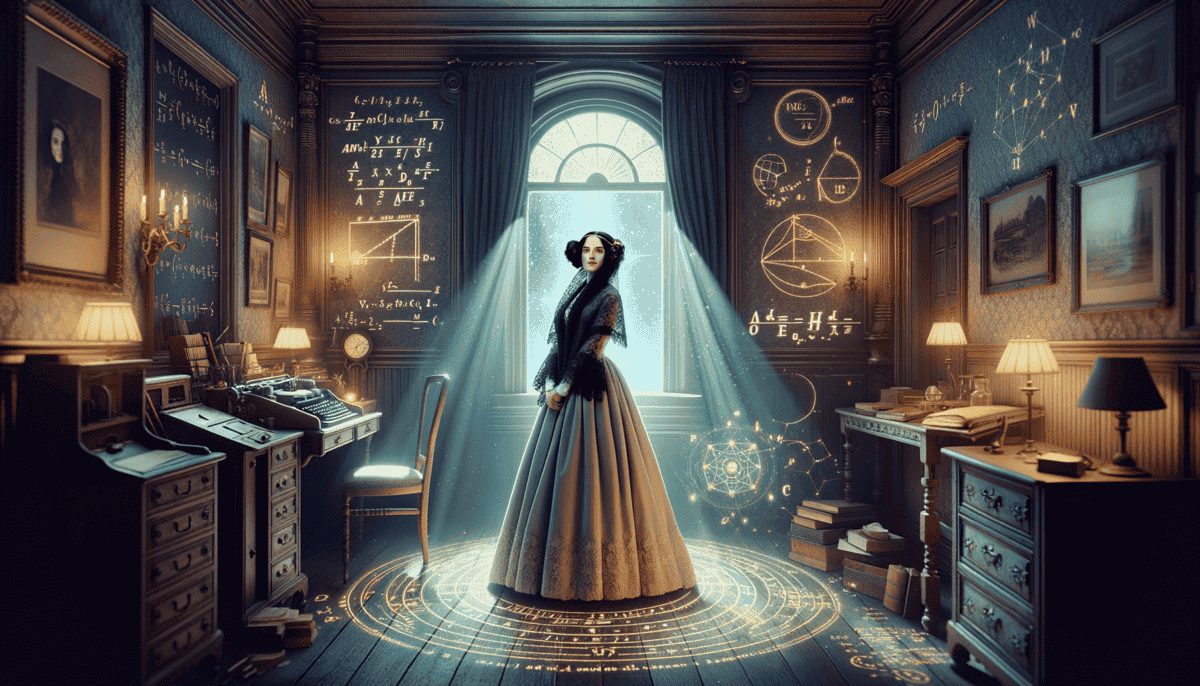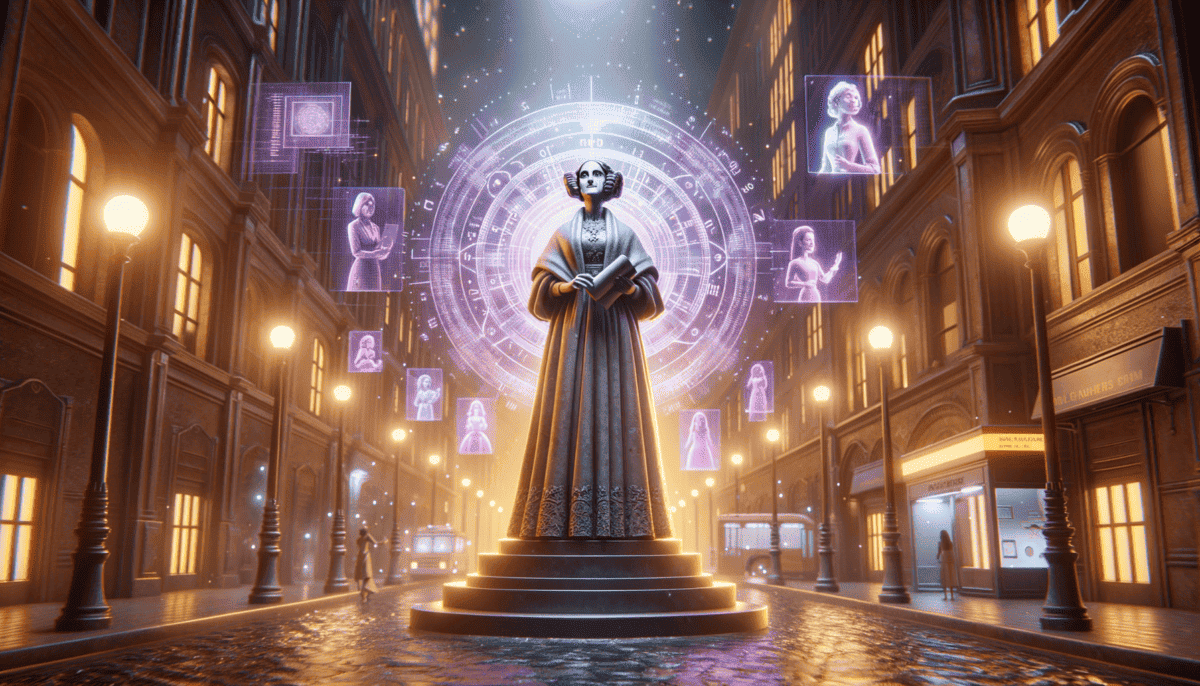The Daughter of Chaos and Order
Little Ada peeked through the library curtains, watching snowflakes dance outside the window of her grand London home. The year was 1821, and at just five years old, Ada already knew she was different from other children.
"Ada, darling, it's time for your lessons," called her mother, Lady Annabella Byron, from across the room.
Ada sighed and turned away from the window. The library was filled with towering bookshelves that seemed to touch the ceiling. Unlike other children her age who played with dolls, Ada spent her mornings studying mathematics and science.
"Yes, Mother," Ada replied, settling into her chair at the sturdy oak table.
Lady Byron spread out papers covered in numbers and shapes. "Today we'll practice geometry," she said firmly. Ada's mother believed that strict education would keep Ada from becoming wild and unpredictable like her father.
But Ada had a secret. While she loved her mathematics lessons, she also had a wonderful imagination. In her mind, numbers weren't just boring figures – they danced and played like the snowflakes outside her window.
"Mother," Ada said excitedly, pointing to a triangle on her paper, "what if this triangle could fly? What if we could make it move with mathematics?"
Lady Byron frowned. "Ada, please focus. Mathematics is about precision and rules, not imagination."
But young Ada couldn't help seeing magic in the numbers. She drew little wings on her geometric shapes when her mother wasn't looking.
Later that evening, Ada sat in her bedroom, surrounded by her favorite books about machines and inventions. She had already read them all twice! While other children her age listened to fairy tales, Ada preferred stories about steam engines and mechanical wonders.
"One day," she whispered to herself, "I'll make something amazing with numbers. Something no one has ever seen before!"
The next morning, during breakfast, Ada asked, "Mother, why can't poetry and science be friends? Like sugar and tea?"
Lady Byron paused, teacup halfway to her lips. "Because, my dear, science is based on facts, while poetry comes from wild emotions – like your father's."
But Ada wasn't convinced. In her heart, she felt that numbers could tell beautiful stories too. She spent her free time creating detailed drawings of flying machines and writing about how they might work.
Her governess often found her scribbling calculations in her notebook, mixing them with imaginative stories about mechanical birds and mathematical butterflies.
"You have your father's creativity," the governess once said, "but your mother's love of order. Perhaps that's not such a bad combination after all."
As Ada grew, she remained caught between two worlds – her mother's world of strict rules and careful study, and the magical world of possibilities she saw in her mind. But instead of letting this tear her apart, it made her special.
She learned to combine both sides of herself: the careful mathematician and the creative dreamer. This unique way of thinking would one day help her see things that others couldn't – things that would change the world.
With her curly dark hair and bright eyes full of curiosity, Ada continued to fill her notebooks with both precise calculations and wonderful ideas. She didn't know it yet, but this special combination would one day make her the world's first computer programmer.
That night, as the snow continued to fall outside her window, Ada made a wish on a bright star. "Please let me grow up to do something amazing with numbers," she whispered. "Something that will make both Mother and Father proud."
The star seemed to twinkle in response, as if it knew that little Ada Lovelace would indeed grow up to do something truly extraordinary. ⭐
Calculating Dreams
The summer of 1833 brought exciting changes for seventeen-year-old Ada. Her mathematical skills had grown as tall as the London church spires she could see from her window.
“Ada, dear, we’ve been invited to a very special gathering,” her mother announced one morning. “Mr. Charles Babbage is showing his new invention – the Difference Engine!”
Ada’s eyes sparkled with excitement. She had heard whispers about this amazing machine that could solve math problems all by itself.
“Will I really get to see it?” Ada asked, hardly able to contain her joy. She rushed to her desk and grabbed her special notebook – the one filled with her mathematical drawings and ideas.
At the demonstration, Ada watched in wonder as Mr. Babbage turned a handle on his machine. The gears clicked and whirred, spinning like dancers in a mechanical ballet.
“This is extraordinary!” Ada exclaimed, moving closer to examine the machine. “How does it know which numbers to calculate?”
Charles Babbage smiled at her enthusiasm. “Would you like me to explain?” he asked, impressed by this young lady’s genuine interest.
For the next hour, Ada and Babbage talked about mathematics and machines. They spoke the same language – a special mix of numbers and imagination that most people couldn’t understand.
“You see,” Babbage explained, “the machine follows a set of steps, like a recipe for baking a cake. Each step tells it what to do next.”
Ada’s mind raced with possibilities. “So if we give it the right instructions, it could do almost anything with numbers?”
Back home, Ada couldn’t stop thinking about the Difference Engine. She filled page after page with notes and ideas. Her mother found her asleep at her desk one morning, mathematical drawings scattered around her.
“My dear,” Lady Byron said gently, “you must remember to rest.”
But Ada could hardly rest. She had discovered something amazing – a way to combine her love of imagination with her mathematical skills. She started writing letters to Babbage, sharing her ideas about his machines.
“What if,” she wrote in one letter, “we could make a machine that doesn’t just work with numbers? What if it could create music or art?”
Babbage was impressed. No one else had thought about machines this way before. He started calling Ada the “Enchantress of Numbers” because she saw magic in mathematics that others missed.
Ada spent her days studying more advanced mathematics. But unlike other scholars, she didn’t just see dry numbers and formulas. She saw patterns like music notes and possibilities like colors in a rainbow.
“Mathematics,” she told her tutor, “is like a beautiful language that can describe anything in the world!”
When Babbage started working on an even bigger machine called the Analytical Engine, Ada was one of the first people he told. This machine was different – it could be programmed to solve all sorts of problems, not just one kind.
“It’s like a mechanical brain!” Ada said excitedly. She understood that this machine could be the key to something revolutionary.
At night, Ada dreamed of machines that could think and create. She imagined a future where people and machines would work together to do amazing things. Her dreams weren’t just dreams – they were glimpses of the future.
One evening, as she wrote in her notebook, Ada made an important decision. She would write down detailed instructions for Babbage’s Analytical Engine – instructions that would make it solve complex mathematical problems. These instructions would become the world’s first computer program!
The young girl who once drew wings on triangles was growing into a brilliant young woman. She was building a bridge between the worlds of imagination and mathematics, and she was just getting started.
As the sun set over London, casting long shadows through Ada’s study window, she smiled at her calculations. She knew she was on the edge of something big – something that would change the world forever. ✨
Breaking Through
Ada sat at her desk, her quill pen scratching against paper as she worked on her notes. Being a woman interested in science wasn’t easy in 1842. Many people thought girls should only learn about cooking and sewing.
“But why can’t I present my ideas at the Royal Society?” Ada asked Charles Babbage during one of their meetings. The Royal Society was a special club where scientists shared their discoveries.
“My dear Ada,” Babbage sighed, “they don’t allow women to join. But that doesn’t mean your work isn’t important.”
But Ada wouldn’t give up. She worked harder than ever on her mathematics. She started writing notes about Babbage’s Analytical Engine in a special way that everyone could understand.
“What if,” Ada thought one morning, “I could write steps for the machine to follow? Like a dance, where each move comes after another?”
She grabbed her pen and began writing. Her first algorithm – a set of steps for the machine to solve complex math problems – was taking shape. It was like writing a recipe, but instead of making cake, it made the machine calculate numbers!
“Mother!” Ada called out excitedly. “I’ve figured out how to make the machine solve Bernoulli numbers!”
Lady Byron peered at the pages of symbols and notes. “My dear, this is quite remarkable. But society may not be ready for such advanced thinking from a woman.”
Ada stood up straight and smiled. “Then society will have to catch up with me.”
Some days were harder than others. Ada often got headaches from working so hard. Sometimes her hands shook from writing for hours. But she kept going.
“Your notes are brilliant,” Babbage told her. “You understand the machine better than anyone else.”
Ada’s notes weren’t just about numbers. She saw something nobody else did – that machines could do more than math. They could create music, art, and even help with science!
She wrote: “The engine might compose elaborate pieces of music of any degree of complexity. It can do whatever we know how to order it to perform.”
Some people laughed at her ideas. “A machine making music? Impossible!” they said. But Ada knew better. She could see the future in her mind.
Late one night, as she worked by candlelight, Ada made a list of all the things she thought machines might do someday:
• Draw pictures
• Make beautiful music
• Help scientists with their work
• Remember lots of information
More than 175 years later, computers can do all these things and more!
Ada kept working on her notes, making them clearer and better. She wanted everyone to understand how amazing these machines could be. She wrote more than 20,000 words explaining how the Analytical Engine worked!
“You see,” she explained to her friend Mary, “the machine follows the instructions like a musician follows sheet music. Each note tells it what to do next.”
Even when she got tired or discouraged, Ada remembered what she was fighting for. She wasn’t just writing about machines – she was opening doors for future scientists, especially girls who dreamed of doing big things. ✨
One evening, as she finished another page of notes, Ada smiled at her reflection in the window. The little girl who once dreamed of flying machines had grown into a woman who could make machines dance with numbers.
“Imagination is the discovering faculty,” she wrote in her diary. “It helps us understand what might be possible.”
Outside her window, the stars twinkled like tiny lights in a giant machine. Ada knew her work was important, even if some people couldn’t see it yet. She was building a bridge to the future, one mathematical note at a time.
The Language of Machines
Ada sat in her study, surrounded by pages of notes about the Analytical Engine. The morning sun streamed through the window as she wrote another line of her special instructions.
“Let’s see… if I tell the machine to take this number and multiply it over and over…” she muttered, her quill scratching across the paper.
Charles Babbage burst into the room, his eyes bright with excitement. “Ada! I’ve made some changes to the Engine’s design. What do you think?”
Ada studied his drawings carefully. “Interesting, Charles. But have you considered how the machine will know when to stop calculating?”
Babbage’s face fell. “I… hadn’t thought of that.”
“Don’t worry,” Ada smiled. “I have an idea!”
She picked up her pen and began writing what she called a “loop” – special instructions that told the machine when to stop doing the same thing over and over.
Multiply it by itself
Check if it’s bigger than 100
If yes, stop
If no, do it again
“You see,” Ada explained, “it’s like teaching the machine to think for itself!”
Babbage looked amazed. “My dear Ada, you truly understand the soul of the Engine.”
Ada worked day after day, writing more complex instructions. She imagined the machine doing things nobody had ever dreamed of.
“What if,” she wondered aloud, “we could make the Engine calculate special numbers called Bernoulli numbers?”
She spent weeks working on this problem. Sometimes she got stuck and had to start over. But Ada never gave up.
“Mother,” her young son Byron asked one day, “why do you write so many numbers?”
Ada smiled. “I’m teaching a machine to dance with numbers, darling. Each instruction is like a step in the dance.”
Her notes grew longer and more detailed. She wrote about:
• Ways to make it do different tasks
• Special symbols to control its actions
• Steps to solve complex problems
• Ideas for future machine uses
“But what if there’s a mistake in the instructions?” Babbage asked one day. ♂️
“That’s why I’m so careful,” Ada replied. “One wrong step could make the whole dance fall apart!”
She created special checks in her instructions to catch mistakes. Today, we call these “debugging” – finding and fixing errors in computer programs.
Late one night, Ada made an exciting discovery. “The Engine doesn’t care if it’s working with numbers or other symbols!” she realized. “It could work with anything that follows rules!” ⭐
She wrote to Babbage: “The Engine might compose elaborate pieces of music. It might create artwork. It could do so much more than simple calculations!”
Some people thought she was dreaming too big. But Ada knew she was right.
“Imagine,” she told her daughter, “a future where machines help us think and create in new ways.”
As autumn turned to winter, Ada finished her notes on the Analytical Engine. She had written more than any other person about how the machine could work.
“You’ve created something remarkable,” Babbage said when she showed him the finished work.
Ada smiled, watching the candle flame dance on her desk. Like that flame, her ideas would light the way for others to follow. The language of machines she created would help build a future she could only imagine. ✨
A Vision Beyond Numbers
The room was quiet except for the scratching of Ada’s pen. She had been working for months on her notes about the Analytical Engine. Now, people were starting to notice.
“Lady Lovelace,” a visitor said one day, “your ideas about machines are quite… unusual.”
Ada looked up from her work, her eyes bright. “The future is unusual, sir. We must think beyond what we know today.”
Letters began arriving from scientists and mathematicians. Some were excited about her work. Others didn’t believe a woman could understand such complex ideas.
“What do they say, Mother?” her daughter asked, watching Ada read the letters.
“Some people aren’t ready for new ideas,” Ada smiled. “But that won’t stop me from sharing them.”
She kept working on her notes, making them clearer and stronger. Her friend Charles Babbage was amazed by her understanding.
Ada believed the Engine could do more than just math. She wrote about machines that could:
• Create pictures
• Help scientists think
• Solve big problems
• Change how people work
“But Mother,” her son asked, “how can a machine do all these things?”
“With instructions,” Ada explained. “Just like you follow steps to bake a cake, machines follow steps to do amazing things.”
One rainy afternoon, Ada sat with her daughter, looking at a music box. “See how the pins make the music play?” she asked. “The Engine could work the same way, but with numbers instead of pins.”
Her daughter’s eyes grew wide. “Could it make any song it wants?”
“Someday,” Ada smiled. “Someday machines will make music we can’t even imagine.”
As her work became known, Ada received more visitors. Scientists wanted to learn from her. Young women looked up to her as an example.
“Lady Lovelace,” a young girl said during one visit, “I want to study mathematics too!”
“Then study,” Ada encouraged. “Don’t let anyone tell you that you can’t.”
Some nights, Ada would look at the stars and think about how far her ideas might go. “The Engine is just the beginning,” she wrote in her diary. “Future machines will do things we can only dream of.” ⭐
She kept writing and thinking, even when she felt tired or sick. Her notes got longer and more detailed. She wanted everyone to understand the power of these new ideas.
“You work too hard,” her mother worried.
“The world needs these ideas,” Ada replied. “Someone must explain them.”
As spring turned to summer, Ada’s notes were finally published. They showed everyone how special the Analytical Engine could be. More importantly, they showed how machines could change the world.
Through her bedroom window, Ada watched children playing in the garden. She smiled, thinking about the future these children would see. A future where machines helped people think, create, and dream in new ways. ✨
A Legacy That Lights the Future
The morning sun streamed through Ada’s window as she looked at her published notes. They were changing how people thought about machines. But she wasn’t done dreaming yet.
“What will you work on next, Lady Lovelace?” asked a young student who came to visit.
Ada smiled, her eyes bright with ideas. “I want to help more people understand how wonderful science can be.”
She started writing letters to schools and universities. “We must teach young minds to dream big,” she wrote. “Science and creativity belong together.”
One day, her daughter found her working late into the night.
“What are you writing now, Mother?”
“I’m imagining machines that can think like we do,” Ada explained. “Someday, they might help us solve problems we can’t solve today.”
Her ideas about machines would one day help create:
• Phones that fit in pockets
• Games that teach while you play
• Robots that help people
• Music made by machines
“But how did you know all this was possible?” people would ask.
“I listened to both my heart and my mind,” Ada would answer. “Science needs imagination to grow.”
Years later, people started building real computers. They found Ada’s old notes and were amazed. She had seen the future long before anyone else!
Now, girls and boys everywhere learn about Ada. Her story shows that anyone can be both creative and scientific.
“Who was Ada Lovelace?” a teacher asks their class today.
“She was the first computer programmer!” the students answer excitedly. “And she was a girl who followed her dreams!”
All around the world, computers do the things Ada imagined. They make art, play music, and help people learn. Just like she said they would!
Scientists named a computer language “Ada” to honor her. Every time someone uses it, they remember the girl who dreamed of teaching machines to think.
Ada’s story reminds us that great ideas can come from anyone, anywhere. She mixed art and science in new ways. She wasn’t afraid to think differently.
“What would Ada think of our computers today?” people wonder.
She would probably smile and say, “This is just the beginning. Keep dreaming bigger!” ⭐
So next time you use a computer, remember Ada. Remember the girl who saw magic in mathematics and music in machines. Remember that your dreams, no matter how big, can change the world.


